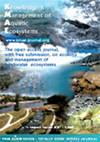陆化河漫滩上深体苦鱼的秋季扩散和有限的繁殖成功
IF 1.7
3区 环境科学与生态学
Q3 FISHERIES
引用次数: 1
摘要
泛滥平原的陆地化已经成为河流管理者和生态学家关注的问题,因为它已经破坏了依赖泛滥平原的生物的栖息地。我们研究了濒临灭绝的深体苦鱼(Acheilognathus longipinnis)在其整个生活史中的时间分布,这是一种秋季产卵的年度鱼类,在unionid贻贝中度过卵和幼虫阶段,并在春季出现,以了解其在日本中部Kiso河陆化洪泛平原上的数量下降。我们首先验证了我们的A. longipinnis环境DNA (eDNA)采样方法,并观察到56个泛滥平原水体(fwb)的eDNA与直接捕获调查之间的一致性概率为89.3%。随后,在长度为1.4 km、宽度为0.2 km的漫滩上采集14个fwb的时间序列eDNA样本,发现14个fwb中有9个存在秋季扩散的时间分布。在接下来的春天,只在与河道相连的两个fwb中发现了幼鱼。此外,直接捕获数据显示,52.9%(9/17)的连接的fwb有幼鱼发生,而与河道隔离的fwb只有5.1%(2/39)的幼鱼发生。在陆化洪泛平原上,有大量孤立的fwb,因此秋散不利于其繁殖。本文章由计算机程序翻译,如有差异,请以英文原文为准。
Autumn dispersal and limited success of reproduction of the deepbody bitterling (Acheilognathus longipinnis) in terrestrialized floodplain
The terrestrialization of floodplains has become a concern to river managers and ecologists because it has degraded habitats for floodplain-dependent organisms. We examined the temporal distributions of the endangered deepbody bitterling (Acheilognathus longipinnis) throughout its life history, which is an autumn-spawning annual fish spending its egg and larval stages in unionid mussels and emerging in spring, to understand its population decline in the terrestrialized floodplains of the Kiso River, central Japan. We first validated our A. longipinnis environmental DNA (eDNA) sampling method and observed an 89.3% probability of consistency between the eDNA and the direct capture surveys of 56 floodplain waterbodies (FWBs). Subsequently, the temporal distributions with autumn dispersal (9 of 14 FWBs) were found using time-series eDNA samples collected from 14 FWBs on a floodplain with a length and width of 1.4 and 0.2 km, respectively. In the following spring, juveniles were only detected in the two FWBs connected to the river channel. Moreover, the direct capture data revealed that juveniles occurred in 52.9% (9/17) of the connected FWBs, but only in 5.1% (2/39) of the FWBs isolated from the river channel. Autumn dispersal of A. longipinnis would be disadvantageous for reproduction in terrestrialized floodplains with numerous isolated FWBs.
求助全文
通过发布文献求助,成功后即可免费获取论文全文。
去求助
来源期刊

Knowledge and Management of Aquatic Ecosystems
环境科学-海洋与淡水生物学
CiteScore
3.70
自引率
5.60%
发文量
22
审稿时长
>12 weeks
期刊介绍:
Knowledge and Management of Aquatic Ecosystems (KMAE-Bulletin Français de la Pêche et de la Pisciculture since 1928) serves as a foundation for scientific advice across the broad spectrum of management and conservation issues related to freshwater ecosystems.
The journal publishes articles, short communications, reviews, comments and replies that contribute to a scientific understanding of freshwater ecosystems and the impact of human activities upon these systems. Its scope includes economic, social, and public administration studies, in so far as they are directly concerned with the management of freshwater ecosystems (e.g. European Water Framework Directive, USA Clean Water Act, Canadian Water Quality Guidelines, …) and prove of general interest to freshwater specialists. Papers on insular freshwater ecosystems and on transitional waters are welcome. KMAE is not a preferred journal for taxonomical, physiological, biological, toxicological studies, unless a clear link to ecological aspects can be established. Articles with a very descriptive content can be accepted if they are part of a broader ecological context.
 求助内容:
求助内容: 应助结果提醒方式:
应助结果提醒方式:


